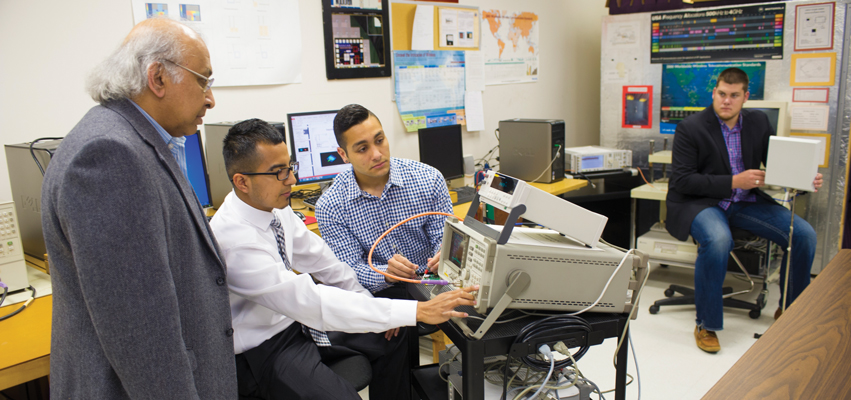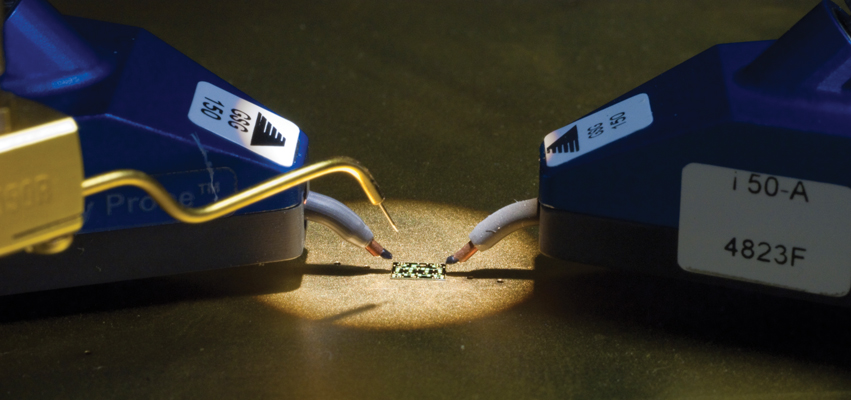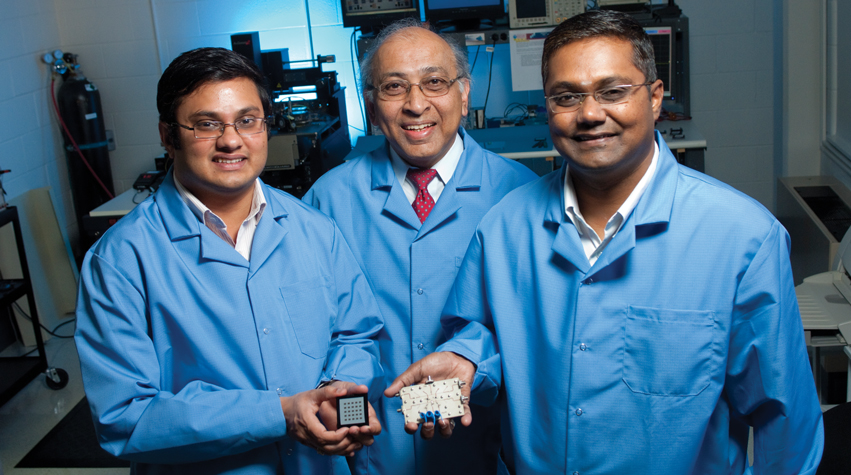
Working with students and industry leaders, Dr. Prasad Shastry has made immense contributions to the development of wireless technologies.
Mobile phones and GPS devices are essential elements of our daily lives today, but it wasn’t always so. Prior to the 1990s, wireless technology was primarily used in defense applications. Dr. Prasad Shastry was a pioneer in this field, having engaged in collaborative research and development activities for more than four decades. As professor of microwave and wireless engineering at Bradley University, he and his students have partnered with a range of companies in the industry—including Northrop Grumman, Fujitsu, TriQuint Semiconductor, Mini Circuits Inc., and Endotronix, to name a few. This collaborative work, he declares, has been among the highlights of his career.
Advances in Wireless Components
All wireless devices—whether digital or analog—contain small, low-profile antennas and radio frequency (RF) circuits, or microchips. Antennas enable the transmission and reception of signals in the air, while RF circuits, placed on an integrated circuit board inside the device, perform various functions such as boosting the energy in the signal.
As a graduate student, Dr. Shastry invented the famous Linearly Tapered Slot Line Antenna (LTSA), which is used throughout the world, including by NASA, among others. At Bradley, he and his team of students have invented several small antennas—including broadband and narrowband antennas, as well as frequency reconfigurable antennas for application in wireless devices.
One current focus of Dr. Shastry’s research involves the cutting-edge area of RF energy harvesting. He and his colleague, Dr. Brian Huggins, are working to develop systems that harvest the energy in RF signals already present in air—or are deliberately radiated for the purpose of power transfer. “The harvested energy can be converted to DC energy and used to charge batteries in devices located in remote areas or even in hazardous environments,” Dr. Shastry explains. In one recent project, the wireless power transfer system was powered by solar energy. “The research and development activity in this area,” he notes, “is being carried out with senior undergraduate students.”

The tunable active duplexer microchip, placed in a wafer probe station for laboratory testing
Amplifying Signal Strength
Earlier in his career, Dr. Shastry made pioneering contributions to the understanding and design of a class of broadband amplifiers known as distributed amplifiers, which are used to boost signal strength in wireless systems over a wide frequency range. They also have the unique property of isolating signals in transmit and receive paths.
This property was exploited in the recent design of a component known as an active duplexer—a small chip that enables the simultaneous transmission and reception of signals, while increasing the strength of signals as they are transmitted and received by wireless devices. Currently, most wireless devices use passive duplexers, which weaken the signals as they pass through them. “Boosting the signal strength allows communication over longer distances,” explains Dr. Shastry. “Further, because the signal strength can be boosted when it enters a wireless device, the sending device can deliver a signal of smaller strength, thereby saving energy.”
The tunable active duplexer chip was designed by Dr. Shastry’s graduate students under his guidance and manufactured by TriQuint Semiconductor in Oregon. The microchip is very tiny—much smaller than a kernel of corn—and can be used in wireless devices such as laptops and Bluetooth-enabled devices. It was tested in the Advanced Microwave Engineering Laboratory at Bradley University, using equipment purchased with a $265,500 grant from National Science Foundation. Dr. Shastry holds two U.S. patents on this invention and is currently working to license the technology to a company in the wireless communications industry.
Inventing a Medical Device
Another noteworthy contribution made by Dr. Shastry concerns early research and experiments on the wireless monitoring of blood pressure in a human heart. This work has resulted in a device for wirelessly monitoring the post-operative blood pressure in the artery of a patient’s heart by implanting a pressure sensor in the artery.
In 2006, Dr. Anthony Nunez came to Dr. Shastry with a request. The cardiothoracic surgeon wanted a device that could measure the pressure in arteries wirelessly, as the traditional blood pressure cuff is not a true indicator of pressure inside the arteries. He and Dr. Shastry initially brainstormed ideas for developing a unit for severe cardiac patients.
The device consists of two components: a biocompatible, pressure-sensitive electronic component—a microcircuit slightly larger than a grain of rice, implanted in the wall of a cardiac patient’s major artery—and a handheld reader that a patient holds in front of their body. The internal sensor sends an RF signal containing real-time blood pressure data to the external reader, which in turn wirelessly transmits the data to the doctor or hospital via the internet. “Thus, the device enables the doctor to monitor the blood pressure after the patient goes home,” Dr. Shastry explains.

Sureshbabu Sundaram, Prasad Shastry and Balamurugan Sundaram, inventors of the tunable active duplexer microchip
Work on this device began at Bradley University in 2006, in collaboration with Endotronix, a company then housed at the Peoria NEXT Innovation Center. The commercial version was developed by graduate students under Dr. Shastry’s guidance, who went to work for Validus, LLC, a subcontractor for Endotronix. In order to develop the product, Endotronix acquired licenses on two inventions patented by NASA’s Glenn Research Center in Cleveland. The work done at Bradley allowed Endotronix to obtain these licenses, which helped secure their first venture capital funding.
“This device, when commercialized, is expected to revolutionize the treatment of heart failure,” explains Dr. Shastry. “The product has gone through successful trials in human beings. This is an excellent example of a three-way collaboration between a university and two companies in developing a product—starting from conceiving an idea to realization of the final product.”
Hands-On Training
Conducting cutting-edge research in the field of RF and microwave engineering is not easy, Dr. Shastry notes. It requires expertise in a highly specialized and technical field—as well as industry-standard, state-of-the art equipment and design tools, with costs ranging in the hundreds of thousand dollars.
“To have all of this coming together in a medium-sized university in a medium-sized city makes it even more commendable,” he adds. “The beneficiaries of these endeavors are firstly the industries that can use these devices; then undoubtedly Bradley University, and especially the students of the engineering program who, when they successfully complete their undergraduate and graduate programs, are able to work in top companies in their fields—confident that they have received a stellar education second to none.” iBi

